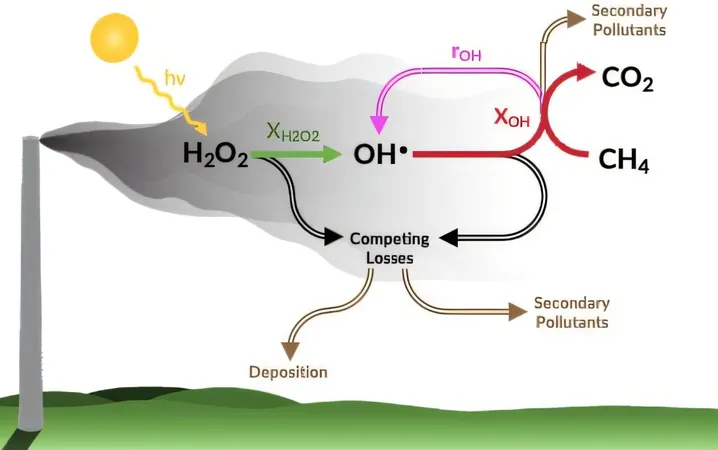
Breakthrough Technology to Cut Atmospheric Methane Revealed as A False Hope, Researchers Warn
2025-01-15
Author: John Tan
As the world grapples with the rising dangers of climate change, the urgent need for innovative solutions is more pressing than ever. However, a new study casts significant doubt on one of the latest proposed technologies aimed at reducing atmospheric methane—a greenhouse gas with an alarming potential for warming.
In a bold attempt to mitigate the greenhouse gas crisis, a Canadian company recently proposed using aerosolized hydrogen peroxide to oxidize methane in the atmosphere and improve air quality. While this idea initially sounds promising, researchers from the University of Utah have conducted a comprehensive study revealing sobering truths about its efficacy and potential unintended consequences.
In their study, titled “Potential Air Quality Side-Effects of Emitting H₂O₂ to Enhance Methane Oxidation as a Climate Solution,” the scientists employed sophisticated modeling to assess the long-term impacts of infusing the atmosphere with hydrogen peroxide. Their findings were stark: this technology is unlikely to achieve meaningful reductions in atmospheric methane levels, and its large-scale implementation could, in fact, worsen air quality, especially in winter months.
Too Good to Be True?
Postdoctoral researcher Alfred Mayhew and assistant professor Jessica Haskins led the study, which was published in the journal Environmental Science & Technology. They voiced their skepticism about the hydrogen peroxide method, stating, “Widespread adoption of this technology would be required to make any meaningful impact on atmospheric methane, and any modest benefits could be dwarfed by negative air quality side effects.”
The research indicated that hydrogen peroxide generates hydroxyl radicals in sunlight, which theoretically could accelerate methane’s conversion to carbon dioxide. However, these radicals are not efficient at oxidizing methane compared to other atmospheric compounds. “OH doesn’t react fast with methane. It’s reacting with so many other things,” Haskins explains.
The Climate Impact of Methane
While often overshadowed by carbon dioxide in discussions of climate change, methane (CH4) is a formidable opponent in the battle against global warming. Over a 20-year period, methane has a warming potential 76 times greater than that of CO2. Despite its relatively short atmospheric lifespan of about 12 years, methane has been responsible for nearly one-third of the rise in global temperatures since the Industrial Revolution, largely stemming from human activities such as oil extraction, gas leaks, and landfills.
Consequences of Geoengineering
The study by Mayhew and Haskins is particularly timely given that recent reports from the National Academy of Sciences have underscored the dangers of atmospheric intervention technologies—something they described as poorly understood and potentially hazardous. Haskins notes, “We could buy ourselves about 50 years and avoid some of the immediate impacts of climate change if we did this, but no one had actually previously done any side-effects studies.”
The researchers employed a global chemical-transport model, GEOS-Chem, to simulate the hydrogen peroxide proposal, estimating the methane reduction under various scenarios. They concluded that even deploying 50 enormous towers—each capable of releasing over a pound of hydrogen peroxide per second—would lead to only a minuscule 0.01% decrease in annual methane emissions. To achieve a meaningful 50% reduction, roughly 352,000 such towers would be necessary—an impractically high figure.
A Call for Caution
The potential side effects of geoengineering projects cannot be overstated. By manipulating the complex systems of Earth's atmosphere, scientists warn that we might invite unforeseen consequences, just as we did with chlorofluorocarbons (CFCs) that led to the depletion of the ozone layer.
“Atmospheric chemistry is just one example. You change one thing and you might think it’s going to do one thing, but it may do the opposite elsewhere,” warns Haskins. “There are so many feedbacks that can occur in the climate system.”
In their findings, the researchers acknowledged that while the deployment of hydrogen peroxide may have limited beneficial impacts if conducted under carefully controlled conditions, the pressing need for thorough evaluations of new technologies before they are implemented is crucial. As the world looks for solutions in the face of climate change, the importance of responsible and informed intervention cannot be overstated.
In summary, while the threat posed by methane is undeniable, the solution involving hydrogen peroxide appears to be a case of promise without delivery—reminding us that in the complex realm of climate science, the search for innovative answers must be approached with caution and rigorous scrutiny.

 Brasil (PT)
Brasil (PT)
 Canada (EN)
Canada (EN)
 Chile (ES)
Chile (ES)
 Česko (CS)
Česko (CS)
 대한민국 (KO)
대한민국 (KO)
 España (ES)
España (ES)
 France (FR)
France (FR)
 Hong Kong (EN)
Hong Kong (EN)
 Italia (IT)
Italia (IT)
 日本 (JA)
日本 (JA)
 Magyarország (HU)
Magyarország (HU)
 Norge (NO)
Norge (NO)
 Polska (PL)
Polska (PL)
 Schweiz (DE)
Schweiz (DE)
 Singapore (EN)
Singapore (EN)
 Sverige (SV)
Sverige (SV)
 Suomi (FI)
Suomi (FI)
 Türkiye (TR)
Türkiye (TR)
 الإمارات العربية المتحدة (AR)
الإمارات العربية المتحدة (AR)